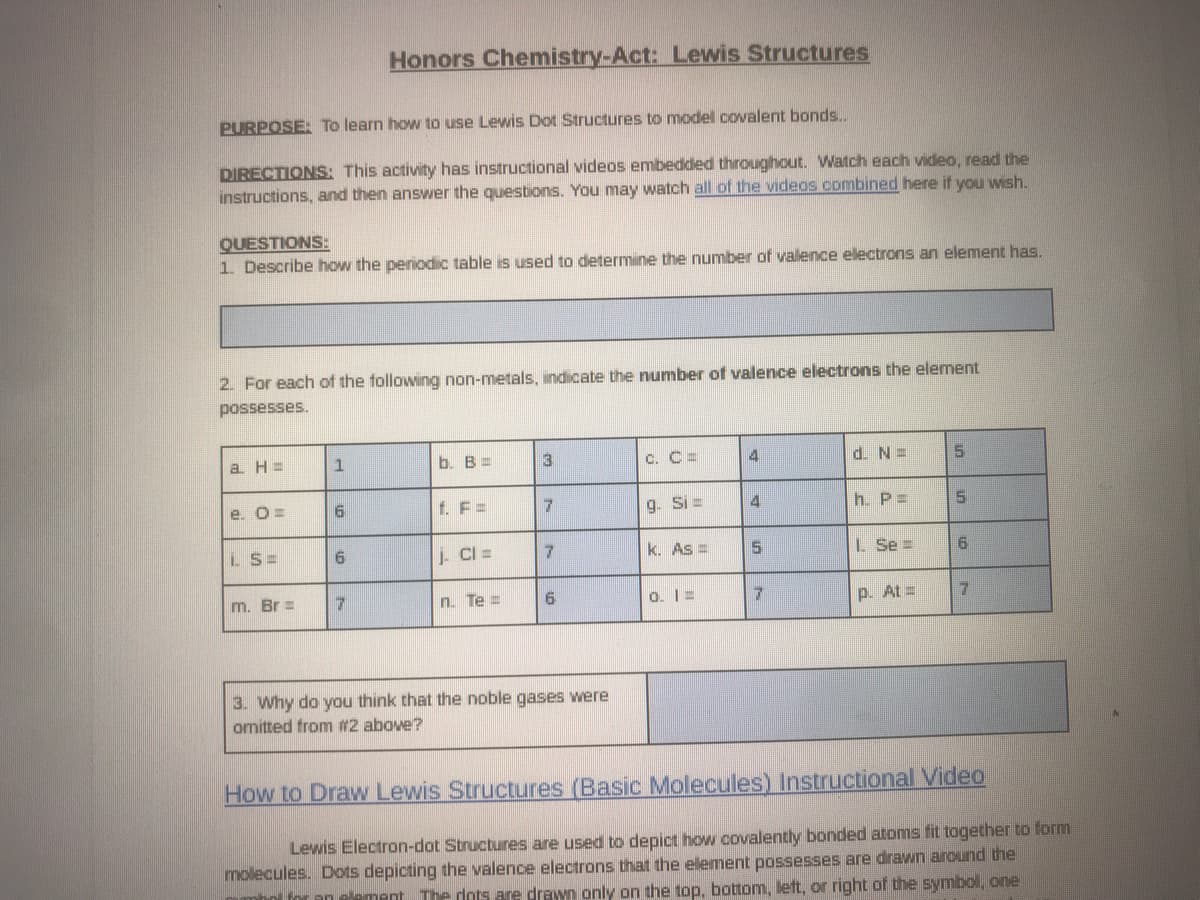QUESTIONS: 1. Describe how the periodic table is used to determine the number of valence electrons an element has. 2. For each of the following non-metals, indicate the number of valence electrons the element possesses. a H= b. B = C. C = d. N= e. O= 6. f. F = g. Si = 4. h. P= L S= 6. j. CI = k. As = L. Se = 6. m. Br = n. Te = 6. 0. 1= 7. p. At = 3. Why do you think that the noble gases were omitted from #2 above? 4. 3. 7. 7. 1.
QUESTIONS: 1. Describe how the periodic table is used to determine the number of valence electrons an element has. 2. For each of the following non-metals, indicate the number of valence electrons the element possesses. a H= b. B = C. C = d. N= e. O= 6. f. F = g. Si = 4. h. P= L S= 6. j. CI = k. As = L. Se = 6. m. Br = n. Te = 6. 0. 1= 7. p. At = 3. Why do you think that the noble gases were omitted from #2 above? 4. 3. 7. 7. 1.
Introductory Chemistry: A Foundation
9th Edition
ISBN:9781337399425
Author:Steven S. Zumdahl, Donald J. DeCoste
Publisher:Steven S. Zumdahl, Donald J. DeCoste
Chapter12: Chemical Bonding
Section: Chapter Questions
Problem 47CR: Which of the following statements is correct and provides the best explanation when removing the...
Related questions
Question
100%
Please answer question 1 and 3 please let it be very short answers

Transcribed Image Text:Honors Chemistry-Act: Lewis Structures
PURPOSE: To learn how to use Lewis Dot Structures to model covalent bonds.
DIRECTIONS: This activity has instructional videos embedded throughout. Watch each video, read the
instructions, and then answer the questions. You may watch all of the videos combined here if you wish.
QUESTIONS:
1. Describe how the periodic table is used to determine the number of valence electrons an element has.
2. For each of the following non-metals, indicate the number of valence electrons the element
possesses.
a H=
b. B=
3
c. C =
d. N =
e. O=
t. F =
g. Si=
4
h. P=
LS=
9.
. CI =
k. As =
I Se =
m. Br =
n. Te =
O. I =
p. At=
7.
3. Why do you think that the noble gases were
omitted from #2 above?
How to Draw Lewis Structures (Basic Molecules) Instructional Video
Lewis Electron-dot Structures are used to depict how covalently bonded atoms fit together to form
molecules. Dots depicting the valence electrons that the element possesses are drawn around the
mhol for an cament The dots are drawn only on the top, bottom, left, or right of the symbol, one
Expert Solution
This question has been solved!
Explore an expertly crafted, step-by-step solution for a thorough understanding of key concepts.
Step by step
Solved in 2 steps

Recommended textbooks for you

Introductory Chemistry: A Foundation
Chemistry
ISBN:
9781337399425
Author:
Steven S. Zumdahl, Donald J. DeCoste
Publisher:
Cengage Learning


Chemical Principles in the Laboratory
Chemistry
ISBN:
9781305264434
Author:
Emil Slowinski, Wayne C. Wolsey, Robert Rossi
Publisher:
Brooks Cole

Introductory Chemistry: A Foundation
Chemistry
ISBN:
9781337399425
Author:
Steven S. Zumdahl, Donald J. DeCoste
Publisher:
Cengage Learning


Chemical Principles in the Laboratory
Chemistry
ISBN:
9781305264434
Author:
Emil Slowinski, Wayne C. Wolsey, Robert Rossi
Publisher:
Brooks Cole

General Chemistry - Standalone book (MindTap Cour…
Chemistry
ISBN:
9781305580343
Author:
Steven D. Gammon, Ebbing, Darrell Ebbing, Steven D., Darrell; Gammon, Darrell Ebbing; Steven D. Gammon, Darrell D.; Gammon, Ebbing; Steven D. Gammon; Darrell
Publisher:
Cengage Learning

Chemistry: Matter and Change
Chemistry
ISBN:
9780078746376
Author:
Dinah Zike, Laurel Dingrando, Nicholas Hainen, Cheryl Wistrom
Publisher:
Glencoe/McGraw-Hill School Pub Co

General, Organic, and Biological Chemistry
Chemistry
ISBN:
9781285853918
Author:
H. Stephen Stoker
Publisher:
Cengage Learning